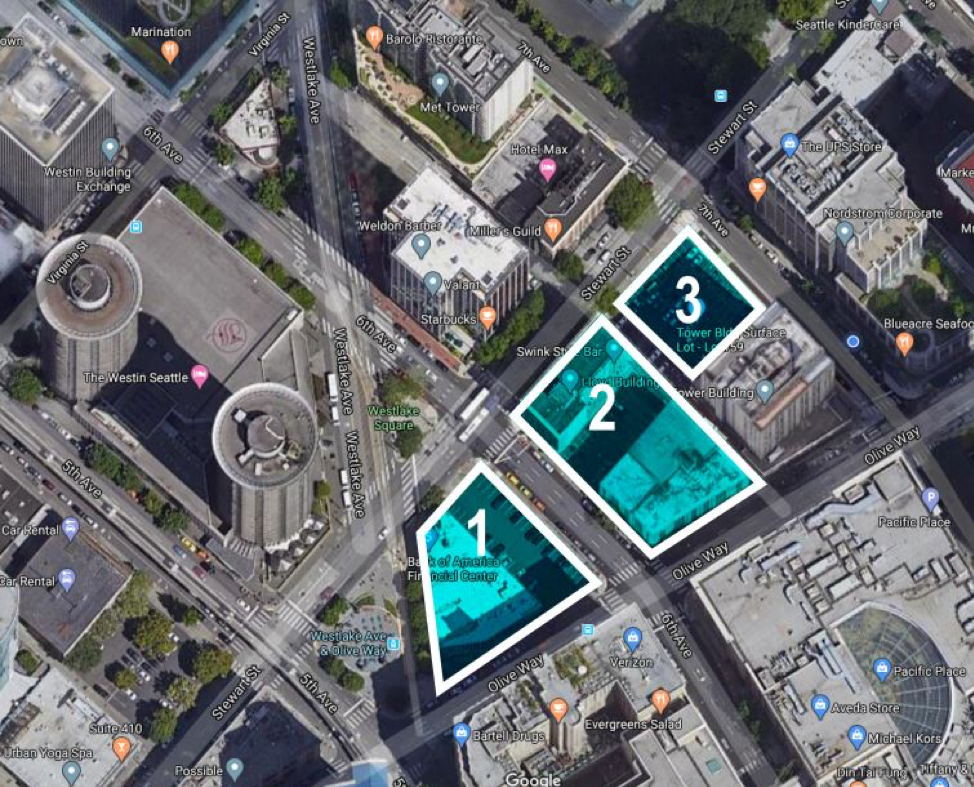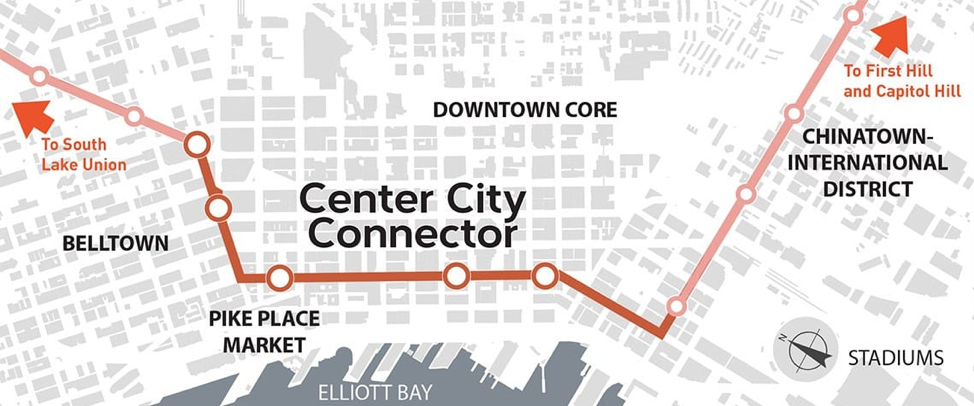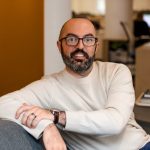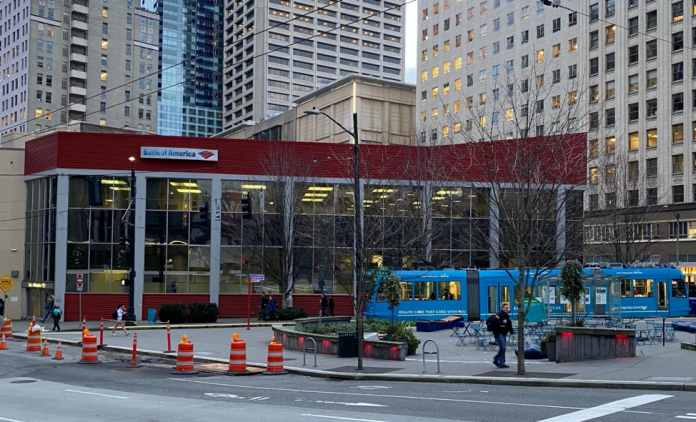Nothing stops the chorus of a city’s urban dance than a parking garage or surface lot. In the booming age of Seattle’s downtown core, with cranes becoming mainstay images of our skyline, it’s amazing that any parking lot still exists in this city. For some major sites located adjacent to the streetcar and within a stone’s throw of Amazon’s main campus, that orchestra is about to commence.
At the end of 2019, Kilroy Realty purchased the sites that included a multi-level parking garage, a single-story bank, a few surface parking lots and the Lloyd Building, a 10-story landmarked office building. The project goals have recently been released and these two blocks are about to gain 7,500 users on any given day. The one and three-quarter block development will bring 900,000 square feet of office space, 25,000 square feet of food and beverage businesses, and over 800 residential units. The developer promises the most sustainable of developments, with carbon neutrality as a key component.

Mixture of Uses
While the Lloyd Building is landmarked, the businesses it houses are not. There is no knowledge if this development will house multiple addresses, like the current layout of the Lloyd Building’s many office tenants, or if the goal is to lease to a larger company. With Seattle’s growth in a single sector, and many of those marquee businesses seeking Seattle as a second hub to their Bay Area headquarters, it’s likely that a larger name is in mind. Either way, the commercial space will house 5,000 or more people commuting to this address every day.
Recent reports show Facebook and Google work forces, as examples, only see 18% drive alone commuters. Google even pays their employees to ditch the car. This means the work forces likely slated for this project will bike, walk or take transit. That is a huge opportunity for this area. The 1,500 residents will likely seek mass transit as well. Between the office use, residences, and retail use, the blocks will see activation from early morning to late evening.
Streetcar Opportunity
Now, more than ever, the Seattle streetcar shows its necessity and value. This massive development sits adjacent to the termination of the South Lake Union Streetcar, a disconnected line that goes from Westlake to the Fred Hutchinson Cancer Research Center. Building the Center City Connector line, linking the South Lake Union line to the First Hill line, was necessary even before this proposal. But now, with the opportunity of moving 5,000 office workers to its front door, or moving 1,500 residents in and around the city, or bringing 800 customers to the restaurants at this project’s base, the need for the streetcar connection is critical.
Over the last year, the streetcar ridership has grown 18%, as more people opt for transit and ditch their cars. Early estimates of the streetcar’s ridership once the connection is completed exceed 22,000 riders per day. For reference, the highest bus ridership in Washington, King County Metro’s RapidRide E Line, tops out at 18,000 daily riders. Squabbling over track sizes and relatively trivial budget items is surely what streetcar opponents in City Hall, from longtime critic Councilmember Lisa Herbold to incoming Transportation Chair Alex Pedersen, are likely to do. And while The Seattle Times has a field day over transit costs, the Center City Connector is a small price compared to Seattle’s car-first infrastructure. The streetcar’s estimated daily ridership of 22,000 would generate enough revenue to operate in the black within eight years, according to the independent review the Mayor ordered. And, more importantly, it will reduce congestion in our growing urban core and move people sustainably.

Bicycle and Pedestrian Opportunity
This project will also activate 7th Avenue, a street that has nearly completed a protected bike lane through the rapidly growing Denny Triangle neighborhood. More than 800 residences and 900,000 square feet of office will be added to 7th Avenue and Stewart Street. High volume bicycle parking is a requirement for all downtown developments and with the mixture of uses and the high likelihood of non-driver modes of transportation, this development is strategically located between the streetcar and existing and planned bicycle infrastructure. The next steps need to address Olive Way and Stewart Street.
These car-first streets are a downtown’s thing of the past. Madrid recently closed off its central downtown to cars and retail sales went up 10%. Cars are not the answer. And, certainly, one-way streets which encourage high-speed connections out of downtown are not something this neighborhood should feature. Olive Way has its own battles just to get some paint for a bus only lane to be added. Stewart Street should narrow, too, removing a lane of car use and expanding the sidewalks for safer pedestrian and bicycle infrastructure.

The Future of Seattle
This Kilroy development’s goals are a microcosm of Seattle’s goals. An active, mixed use, carbon-neutral development on the key spines of sustainable transportation. Seattle is growing and changing. Sometimes it closes our favorite coffee shop or bar, and sometimes it bulldozes a lifeless parking garage. Either way, these changes occur in a rapidly growing city.
The components our planning are critical in swaying how we use space and how we get around. The developer has already seen the opportunity this site has in moving its users through our city. Strategically locating itself on a streetcar stop, adjacent to a major bus connection on Olive Way, and connected to the protected bike lane of 7th Avenue all have influenced the goals of carbon neutrality. The sustainable statement being made is clear.
The symphony of urban mobility, as people dance from one use to another, in one mode or another, is an orchestra this project will conduct. We do not need delays on the City Connector streetcar expansion. We do not need delays for bike and pedestrian infrastructure. What we need is leadership in our climate-concerned mayor to not only encourage and expand these transportation modes, but also reduce the troubling aspect of car infrastructure, or our climate goals will not be achieved.

Ryan DiRaimo
Ryan DiRaimo is a resident of the Aurora Licton-Springs Urban Village and Northwest Design Review Board member. He works in architecture and seeks to leave a positive urban impact on Seattle and the surrounding metro. He advocates for more housing, safer streets, and mass transit infrastructure and hopes to see a city someday that is less reliant on the car.

